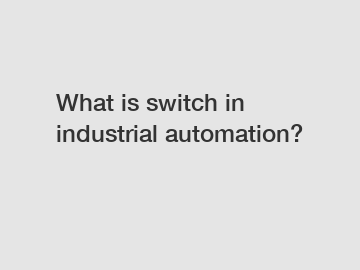What is switch in industrial automation?
What is switch in industrial automation? A critical component in industrial automation systems, switches play a vital role in managing the flow of information, signals, and power within machinery and control systems. With their ability to control multiple circuits simultaneously, switches are essential for various applications, from managing process control to improving safety measures. In this article, we will delve into the intricate world of switches in industrial automation, exploring their different types, functions, and significance.
1. Types of switches:
- Limit Switches: Used to detect the presence or absence of an object, limit switches are crucial in ensuring safe and efficient machine operations. They are commonly employed to control the movement of robotic arms, conveyors, and elevators.

- Push Buttons: These switches are manually operated and are often found on control panels. Push buttons can be used to start or stop a process, initiate an emergency shutdown, or activate specific functions in a machine.
- Selector Switches: Designed with multiple positions, selector switches enable users to choose from various options or modes within a system. They are commonly used in motor controls, allowing operators to switch between forward, reverse, and off positions.
- Proximity Sensors: Although not traditional switches, proximity sensors serve a similar purpose. They detect the presence of an object using electromagnetic fields or infrared radiation and are often used to automate processes without physical contact.
2. Functions and applications:
- Process Control: Switches are fundamental in controlling different stages of a manufacturing process. They can initiate or halt specific tasks, adjust parameters, or regulate speed and direction in machinery.
- Safety Measures: In industrial automation, switches are extensively employed to enhance safety measures. For instance, emergency stop switches (E-stop) are crucial components that immediately terminate operations in potentially hazardous situations, preventing accidents and injuries.
- Feedback Mechanism: Switches are used to provide feedback to the control systems, indicating the status of a particular process or component. This feedback enables operators to monitor and troubleshoot any issues efficiently.
- Power Management: By controlling circuits, switches aid in efficient power management. They allow energy to be distributed to different parts of a system as required, minimizing wastage and optimizing operation.
- Sequential Control: Industrial automation often involves sequences of operations. Switches play a pivotal role in initiating these sequences or determining the order in which tasks are executed.
3. Importance of reliable switches:
- Reliability: Switches must be highly reliable to ensure uninterrupted and safe operation of machinery. Malfunctioning switches can lead to costly downtime, increased maintenance, or even accidents. Therefore, switches manufactured with high-quality standards and rigorous testing are imperative.
- Durability: Industrial environments are often harsh, with exposure to extreme temperatures, dust, vibrations, and chemicals. Switches need to be robust and able to withstand these conditions to maintain functionality and longevity.
- Accuracy: In critical applications, such as precision manufacturing, switches must provide accurate and repeatable results. Any deviation in switching actions can impact product quality and overall productivity.
4. Advances in switch technology:
- Smart Switches: With advancements in automation and the implementation of the Internet of Things (IoT), switches are becoming smarter. These switches can collect and transmit data, allowing for remote monitoring, predictive maintenance, and improved overall system efficiency.
- Integrated Safety Functions: Some switches now come equipped with integrated safety functions, eliminating the need for separate safety devices. This integration simplifies installation, reduces costs, and enhances safety in industrial environments.
In conclusion, switches are the backbone of industrial automation systems, enabling precise control, efficient operation, and enhanced safety measures. From limit switches to push buttons and proximity sensors, each type serves a unique purpose in process control, power management, and sequential operations. The reliability, durability, and accuracy of switches are crucial factors to consider for smooth and safe industrial automation. As technology advances, smart switches and integrated safety functions are revolutionizing the way switches contribute to maximizing efficiency and productivity in the industrial realm. So, the next time you encounter a switch in industrial automation, remember its indispensable role in keeping processes running smoothly.
For more information, please visit What is a Limit Switch Used For?, Long Lever Micro Switch, Industrial Limit Switch Factory.
207
0
0

Comments
All Comments (0)